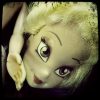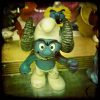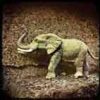Techincal Info
Bruno Cattani's photographs, allow us to enter into the world of children's poetry; starting from small things, children can transform the world, from objects that, while they play, become something else, they take on new meanings and come to life.
They allow us to see, hear the "sign" of the dream, the sign of the most profound life in the objects precious to children, therefore precious to each one of us. Piergiuseppina Fagandini
Technical Information
C-prints, cm 30 x 30 edizione di 5 + 2 p.a. , cm 100 x 100 edizione di 3 + 1 p.a
Press Release
“The first traces of man's poetic activity are in a child's play. The child at play behaves like a poet; he builds his own world, or rather, gives to his liking a new arrangement of the things of his world”
Freud, “The Relation of the Poet to Daydreaming”
Bruno Cattani's photographs, allow us to enter into the world of children's poetry; starting from small things, children can transform the world, from objects that, while they play, become something else, they take on new meanings and come to life.
This magic happens in every place where a child is playing, at home, at nursery school, in kindergarten, in a child psychotherapy room; it has always happened, in every century as evidenced by the toys in the Egyptian tombs of thousands of years ago and through the toy's contemporary industry and cartoon characters.
Cattani has managed to capture the toy-objects after they have been transformed by the play of children. Toys on their own, if not used, played with, have no life. They are all the same, they are concrete objects. But if a child has touched them, loved them, battered and transformed them, they live; the signs of emotions, fantasies they represented in the game, and that the children have lived through them, leave a trace you can see and "feel" in the color, the shape, the position in which they are left. This is the poetry of Cattani's photography; it captures and makes visible the enchantment of these traces. Traces of pleasure, joy, adventure, courage, but also of fear, sadness, anguish.
While playing children symbolically represent fantasies, fears, desires, experiences, and in doing so they use the same language and the same form of archaic expression that is phylogenetically acquired and well known in dreams. A child's play can be assimilated to the adult dream. The conscious and unconscious fantasies of the child and his mental representations, find in the game their mise-en-scene, just like the dream is the mise-en-scene of the adult unconscious fantasy. "We can fully understand what children express through the game if we look at it from the point of view of the method developed by Freud to reveal dreams" (M. Klein). The essential tool for child psychotherapy is the game, while the psychoanalysis of adults is based on dreams. It is thought to be impossible to photograph dreams. Cattani makes it possible to photograph children's dreams.
The toy, the act of playing, represent the transition between desire and reality, they guarantee its possibility. The transition process is played on the edge, a secret and individual margin where one experiences a non-hazardous, non-threatening solitude, a place where each one of us is a total master of himself, where we can live in freedom and in mystery, alone or in the company of someone. It is the matrix of the production of the human mind, of culture and art.
Cattani's photographs allow us to see, hear the "sign" of the dream, the sign of the most profound life in the objects precious to children, therefore precious to each one of us. Piergiuseppina Fagandini
Biography
Bruno Cattani lives and works in Reggio Emilia.
He began his career in photography in 1982 and has been a photojournalist since 1988. In 1996 he took part in a photographic research on the museums of Reggio Emilia, thus started his research on "Places of art." Over the years he received numerous research commissions in museums such as the Musée Rodin, the Musée du Louvre, the Ecole Nationale Supérieure des Beaux-Arts in Paris, the National Institute for Graphics, the Pergamon Museum in Berlin and the Archaeological Superintendence of Pompeii. He is one of the artists in the E 'D'après L’Antique exposition the Museum du Louvre and, in the same year, his show “Places of Art” is inserted into the program of the Mois de la Photo in Paris. In 2005 he began his research on memory unfolding like a journey seeking to revive the past with emotional and evocative narrative images In the spring of 2010 this becomes an exhibition “Memorie” accompanied by a the book of the same name, curator Sandro Parmiggiani. He has takes part in the third edition of Reggio Emilia – Fotografia Europea. He is currently working for some of the most important Italian Architect Studios and his works are part of the permanent collections of the Archives Photographiques du Musée du Louvre, Maison Européenne de la Photographie in Paris,,the New York Public Library for the Performing Arts, Museo Archeologico Nazionale of Naplesi Bibliotéque Nationale de France, Paris, Musée Réattu d’Arles, Musée de la photographie de Charleroi, Musée Nicephore Niéce Ville de Chalon sur Saône, Maison, The United States Museum of Photography, and the Museum of Thessaloniki (Greece). In 2011 he was invitated at the 54th International Biennale in Venice.



